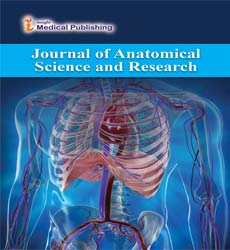Brief Note on Cerebrospinal Fluid
Domer brinker
Department of Neurosurgery, University College London, London, United Kingdom
- *Corresponding Author:
- Domer brinker
Department of Neurosurgery, University College London, London, United Kingdom
E-mail: dbrink@gamil.com
Received Date: December 03,2021; Accepted Date: December 16, 2021; Published Date: December 23, 2021
Citation: Brinker D (2022) Brief Note on Cerebrospinal Fluid. J Anat Sci Res Vol:4 No:6
Editorial
By transporting Na+, Cl, and HCO3 from the blood to the brain's ventricles, the epithelial cells of the choroid plexuses generate cerebrospinal fluid (CSF). Due to the polarity of the epithelium, ion transport proteins in the blood-facing (basolateral) membrane differ from those in the ventricular (apical) membrane, allowing for unidirectional ion transport. An osmotic gradient is created by the flow of ions, which stimulates H2O secretion. The expression of ion transporters and channels in the choroid plexus epithelium has been determined using a range of approaches (e.g. isotope flux studies, electrophysiological, RT-PCR, in situ hybridization, and immunocytochemistry). The majority of these transporters have now been identified as belonging to particular membranes. Na+-K+ATPase is a good example. The apical membrane contains K+ channels and Na+-2Cl-K+ cotransporters. The basolateral membrane, on the other hand, contains Cl- HCO3 exchangers, a variety of Na+ linked HCO3 transporters, and K+-Cl exchangers. cotransporters. Water is transported across the apical membrane by aquaporin 1, but the pathway across the basolateral membrane is unknown. These proteins are accommodated in a model of CSF secretion by the mammalian choroid plexus. The model also explains how K+ is transferred from the CSF to the blood stream. CSF absorption has long been thought to primarily involve draining into the venous outflow system through the intracranial arachnoid granulations. Recent research suggests that networks including spinal arachnoid granulations and lymphatic channels may also play a role in CSF outflow.
Physiological tests revealed that a functioning channel existed between the CSF and the blood. Initially, electron microscopy research revealed that the arachnoid villi were only covered by complete cellular membranes, with tight connections connecting the cells. Following investigations revealed indications of functional changes in the villi membranes, indicating the formation of transient channels through the cell. These channels serve as a temporary link between the two parts of the body. Additionally, as pressure in the subarachnoid space rises, the cells of the arachnoid villi thin, cell connections split, and the number of pinocytosis vesicles generated on the CSF side of the cell rises dramatically. As a result, the bulk flows of CSF into the circulatory increases. The subarachnoid space's pressure rises.
In the central nervous system, Cerebrospinal Fluid (CSF) performs a variety of activities. Despite several papers describing CSF and its circulation in the subarachnoid area, we know very little about CSF outflow. Although early research suggested that arachnoid granulations and lymphatic capillaries both had a role in CSF outflow, the arachnoid granulations have received the most attention since then. A rising amount of evidence suggests that not only do arachnoid granulations and lymphatic capillaries play important roles in CSF outflow, but that extra contributions via tran’s ependymal transit also play a role. We can better comprehend the importance of CSF outflow in health and sickness if we take into account all mechanisms and routes.
Biochemical indicators in the Cerebrospinal Fluid (CSF) for Alzheimer's Disease (AD) would be extremely useful in improving the clinical diagnostic accuracy of the disease. Two tests based on numerous well-defined monoclonal tau antibodies were employed to analyse these proteins in CSF since improperly phosphorylated versions of the microtubule-associated protein tau have been consistently discovered in the brains of AD patients, and tau may be detected in CSF. The first identifies most normal and pathological forms of tau (CSF-tau), whereas the second is very selective for phosphorylated tau (CSF-tau) (CSF-PHFtau).
Open Access Journals
- Aquaculture & Veterinary Science
- Chemistry & Chemical Sciences
- Clinical Sciences
- Engineering
- General Science
- Genetics & Molecular Biology
- Health Care & Nursing
- Immunology & Microbiology
- Materials Science
- Mathematics & Physics
- Medical Sciences
- Neurology & Psychiatry
- Oncology & Cancer Science
- Pharmaceutical Sciences
